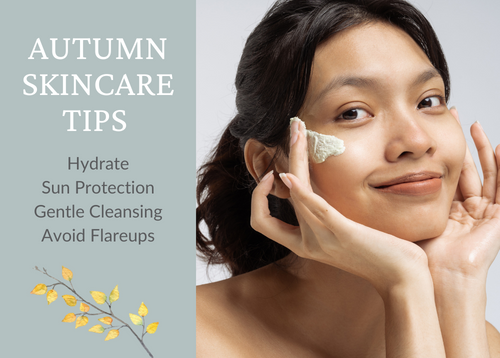17 Oct Skincare For the Fall Season
 Shorter days and cooler temperatures are sure signs that summer is coming to an end. Fall weather can have both positive and negative effects on the skin due to changes in temperature, humidity levels, and environmental factors.
Shorter days and cooler temperatures are sure signs that summer is coming to an end. Fall weather can have both positive and negative effects on the skin due to changes in temperature, humidity levels, and environmental factors.
Here are a few ways that the fall season can affect your skin:
Dryness and Dehydration:
As the weather becomes cooler, the air tends to be drier. Lower humidity levels can lead to skin dryness and dehydration, making the skin feel tight, flaky, and itchy.
Moisture Loss:
The transition from warm, humid summer weather to cooler, drier fall weather can cause the skin to lose moisture more rapidly, resulting in increased transepidermal water loss (TEWL). This can lead to dry patches and a dull complexion.
Wind Exposure:
Windy weather in the fall can strip the skin of its natural oils and moisture, causing irritation, redness, and chapped skin, especially on exposed areas like the face and hands.
Sun Exposure:
Even though the sun may not feel as intense in the fall, UV rays can still cause skin damage. It’s important to continue using sunscreen or sunblock to protect the skin from harmful UV radiation.
Temperature Fluctuations:
Fluctuating temperatures between cool outdoor air and heated indoor spaces can cause stress on the skin, leading to increased sensitivity and potential flare-ups of skin conditions like rosacea or eczema.
Exacerbation of Skin Conditions:
Individuals with skin conditions such as eczema, psoriasis, or rosacea may find that the change in weather exacerbates their symptoms, causing more redness, itching, or irritation.
Changes in Skincare Needs:
With the onset of fall, you may need to adjust your skincare routine to include more hydrating products, such as heavier moisturizers and hydrating serums, to combat dryness and keep the skin adequately moisturized.
Fall Allergies:
Fall can be a time for increased allergens, such as pollen and mold, which can trigger allergic reactions in some individuals. Allergic reactions may manifest as skin rashes, redness, and irritation.
To mitigate the effects of fall weather on your skin, consider the following tips:
Hydrate Well:
Drink plenty of water and use hydrating moisturizers to keep your skin hydrated. Apply a daily facial moisturizer with hyaluronic acid and ceramides to help hydrate skin and lock in moisture. Regular use provides effective moisturization day and night.
Use Gentle Facial Cleansers:
Avoid harsh cleansing agents in your soap or body wash. A fragrance-free soap tends to be less irritating to your skin. Take lukewarm showers or baths. Hot water can strip the skin of its protective barrier.
Protect Your Skin:
Use sunscreen with at least SPF 30, even on cloudy days, to protect your skin from UV rays. Exposure to sunlight should be a concern no matter what the temperature is outdoors.
Dress Appropriately:
Layer clothing. It will help you adapt quickly to changing temperatures and potentially avoid sweaty skin. Sweat may leave your skin more prone to flareups and breakouts.
Shield your skin from harsh winds and cold temperatures by wearing protective clothing like scarves, gloves, and hats to
Finally, avoid flareups. Some skin conditions may react negatively to cooler weather and cause skin to become more sensitive to potential allergens found in ordinary moisture rich products. The best skin care products for sensitive skin are formulated to avoid harsh ingredients which may help avert unwanted flareups. Remember to always read the label and check the ingredient list. Products labeled as ‘hypoallergenic’ may still contain allergens.
If you have specific skin concerns, it’s advisable to consult a dermatologist for personalized recommendations and treatment options based on your skin type and condition. To prepare your skin for the changing fall season, give us a call. We can help. Schedule an appointment today.


